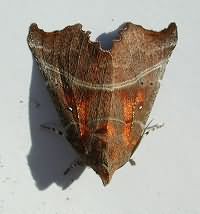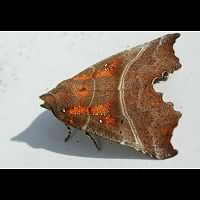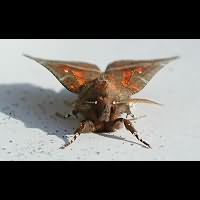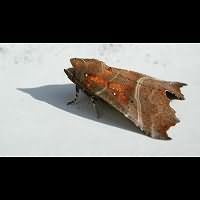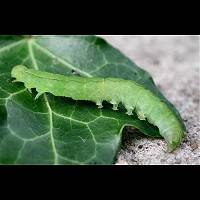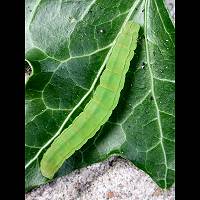Herald Scoliopteryx libatrix
The Herald is an unmistakable species: brownish with orange patches, clear thin white lines over the wings, white dots and a very indented edge of the wing. There are no similar species at all. The only variations are in shade and the extend of the orange patches. Male and female do not differ in markings at all, but the male has feathered antennae, whereas the female has ordinary wire-like antennae. Also the wingspan is not very variable, for it is always in the 44 to 48 mm range.
Except for a few places in the south of England, the Herald is single-brooded in Britain. But adults have a long life span and may live from July to June next year. The eggs are deposited separately or in very small groups from March to the end of June. Larvae appear from June to August. The caterpillars are silky and light green on top, the underside is whitish green. There is a dark dorsal line, but it is very thin and sometimes hardly visible. On the sides runs a greenish line with small black borders. The spiracula are very inconspicuous and a hardly visible whitish line may run over them. The head is rather big, round, green and has a black line running through the middle. The caterpillar of the Herald spins a rather big, white, silken cocoon to pupate in. It is usually attached to two leaves, often at the end of a thin twig. The foodplants are fast growing trees such as poplars and willows. The larvae are slender and long. The length may be anything up to 50 mm.
The Herald can be seen almost all year long, except for a break in June. This species overwinters being adult. It is often seen overwintering, for it likes to do so in tunnels, stables, sheds and cellars. It prefers rather damp places. Often overwinters in small groups. Flies by night, but is regularly seen in gardens sucking on ivy, overripe fruit or sugar. It's tongue is strong enough to break through the skin of ripe berries. Is not easily disturbed during the day and may even be handled by photographers. Quite common in England, Wales and Ireland, scarcer in Scotland, but locally present all the way to the Northern parts of Orkney. Also a rather common species in other parts of Europe, including most of Scandinavia.
The Herald is an unmistakable species: brownish with orange patches, clear thin white lines over the wings, white dots and a very indented edge of the wing. There are no similar species at all. The only variations are in shade and the extend of the orange patches. Male and female do not differ in markings at all, but the male has feathered antennae, whereas the female has ordinary wire-like antennae. Also the wingspan is not very variable, for it is always in the 44 to 48 mm range.
Except for a few places in the south of England, the Herald is single-brooded in Britain. But adults have a long life span and may live from July to June next year. The eggs are deposited separately or in very small groups from March to the end of June. Larvae appear from June to August. The caterpillars are silky and light green on top, the underside is whitish green. There is a dark dorsal line, but it is very thin and sometimes hardly visible. On the sides runs a greenish line with small black borders. The spiracula are very inconspicuous and a hardly visible whitish line may run over them. The head is rather big, round, green and has a black line running through the middle. The caterpillar of the Herald spins a rather big, white, silken cocoon to pupate in. It is usually attached to two leaves, often at the end of a thin twig. The foodplants are fast growing trees such as poplars and willows. The larvae are slender and long. The length may be anything up to 50 mm.
The Herald can be seen almost all year long, except for a break in June. This species overwinters being adult. It is often seen overwintering, for it likes to do so in tunnels, stables, sheds and cellars. It prefers rather damp places. Often overwinters in small groups. Flies by night, but is regularly seen in gardens sucking on ivy, overripe fruit or sugar. It's tongue is strong enough to break through the skin of ripe berries. Is not easily disturbed during the day and may even be handled by photographers. Quite common in England, Wales and Ireland, scarcer in Scotland, but locally present all the way to the Northern parts of Orkney. Also a rather common species in other parts of Europe, including most of Scandinavia.

